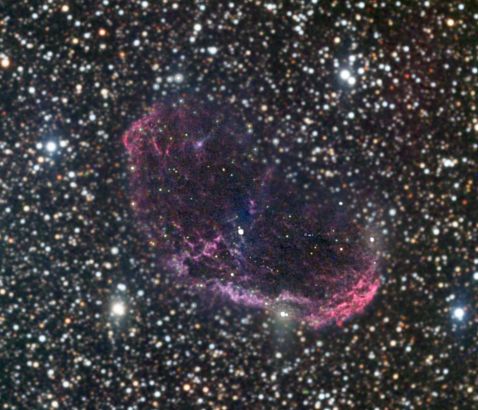
The Crescent Nebula is a patch of nebulosity in Cygnus. The nebula got its name from the arc-like appearance in a telescope. The appearance of the nebula is similar to that of a supernova remnant. However, it is actually a rare planetary nebula surrounding a Wolf-Rayet star. The 7th magnitude intensely hot Wolf-Rayet star HD 192765 in the center is the source of the gas and is also the source of the radiation that excites the gas sufficiently to make it glow. The radiation from this star drove away gas at speeds of 3 million miles per hour, and the fierce stellar wind collided with gas shed earlier to create the glowing shell that we see as the Cresent Nebula. Elements of the nebula can be seen with a telescope as small as 75mm (3 inches). However, the full curve of the nebula is typically visible only in a scope of at least 300mm. The Crescent Nebula is located about two degrees from M29.
This is an LRGB color composite CCD image assembled from images taken over the course of three nights. The nebula was imaged using a hydrogen alpha filter, and data was collected for two nights using an ST-8E binned 1x1 and MAXfilter. The color data was taken on the third night using a CFW-8 color filter and an ST-8E binned 2x2. The scope used was a Takahashi FCT-150 refractor. The image was processed and assembled using MaxIm DL and PhotoShop.
NGC 6888
Constellation: Cygnus
RA: 20h 12m 06s Dec: +38d 21' 18" (J2000)
May 28, 2003
Image by Sid Leach
Scottsdale, Arizona
Recent Images.
Complete list of images.
Description of equipment used to acquire images.
Home
Feedback and comments should go to Sid